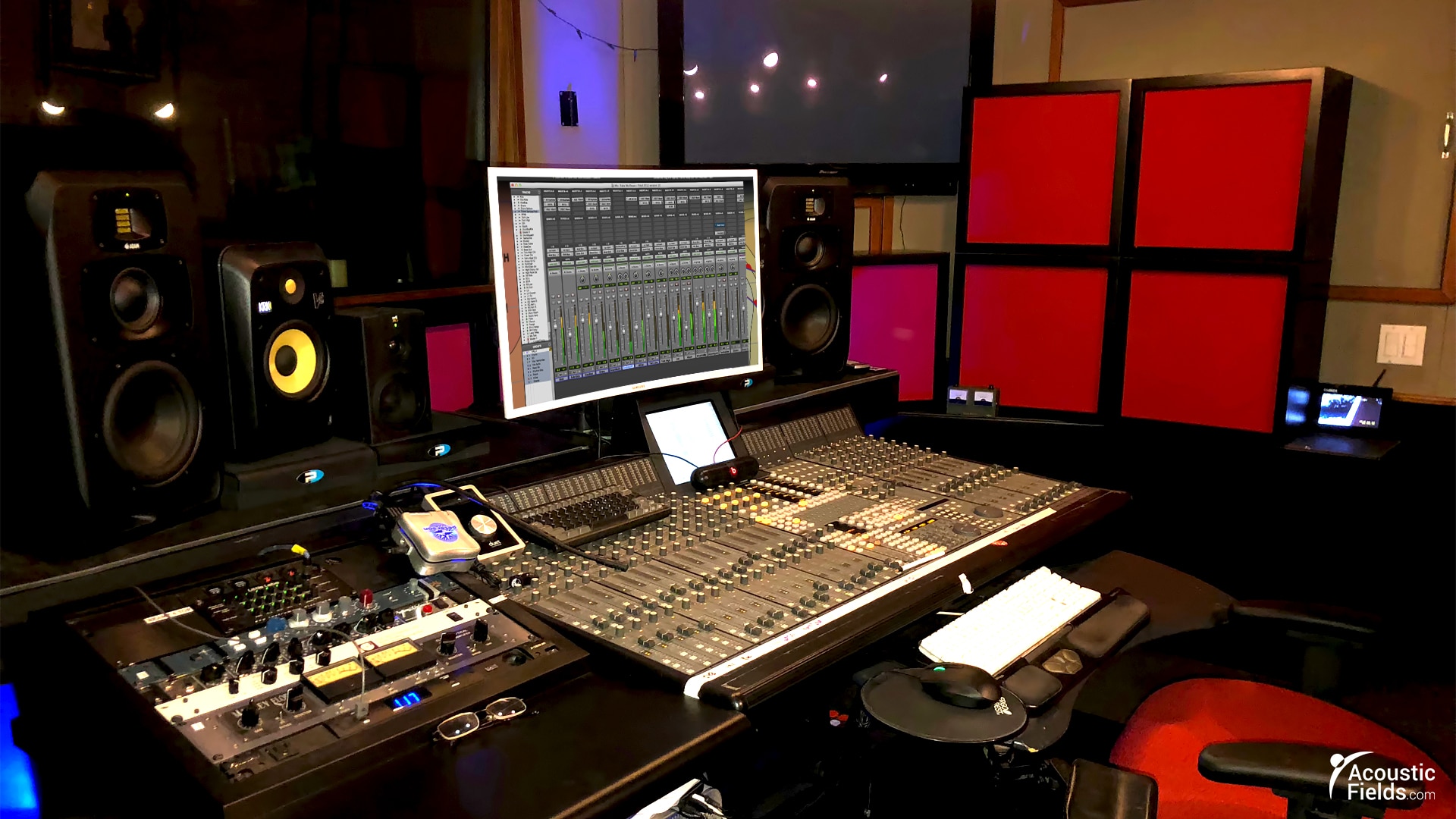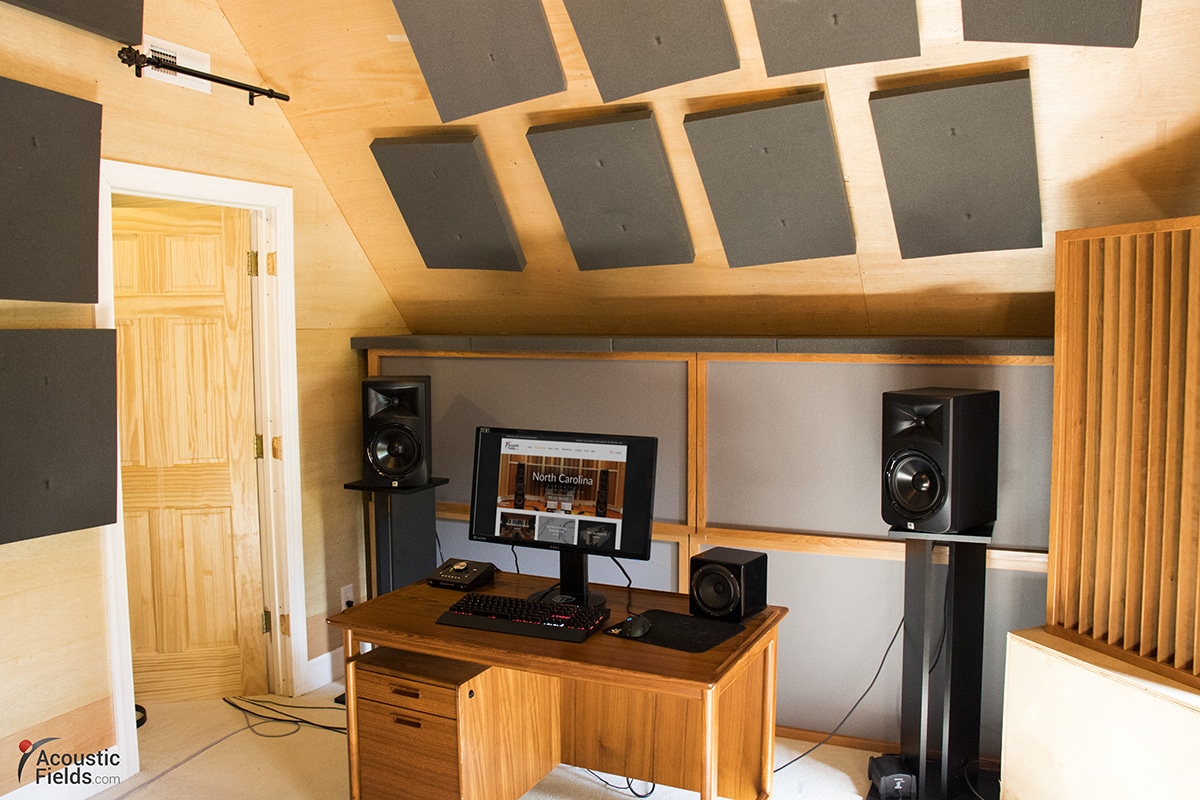In last weeks Google Hangout I was asked “Where should I start when measuring the frequency response of a room? Should I trust my ears or my charts and graphs more?” Well it’s a balance between the two things. What is our goal with our music room; to connect to the music in our rooms emotionally? How do we do that? We have to back up a little bit.
First we have to get rid of the problems that the room causes. How do we do that? Numbers and graphs are a great way and that’s the objective side of room acoustics. Define the problem, the graph will tell you the extent of the problem and where the problem lies. It won’t tell you where the problem exists within your room however. That can be found but not with today’s technology that’s readily available in the marketplace. It takes a more systematic approach and that’s what we’ve done with our database.
We have a 116-room database and we put 16 to 20 different microphones in the room and measured every spot in the room. So we know exactly where the pressure issues are in the room based on room size. Well the average person can’t do that. He can do a frequency response measurement of the room, he can find out where the peaks and the troughs are, where the dips are, where the holes are if you will in the room response.
Measure the frequency response of your room first
So measure the room, find out where our issues are then we go about taming those issues in a systematic way so that we can hear more of the music. Now that said, as we begin that tuning process and as we move forward solving those problems that the room response curve show us, more of the music will start to surface. More of the energy, more of the recording nuances and subtleties will start to surface within our room that’ll bring us closer emotionally to the music.
So it’s a combination of both, solving the problems on the objective side using charts and graphs, then fine tuning those issues once we solve them so that we connect to the music more emotionally.
Now that said, is there a chart or a graph that tells you you’re connecting to the music emotionally? No. this is the subjective part of room acoustics. Some people like more low-end, some people like more middles, some people just like vocals, some people like high-end stuff (hopefully not too many people like that).
But anyway the bottom line is use the charts and graphs to pinpoint the problems, apply the correct room treatment to minimize those issues and then it’s a tuning process from then on and you’ll know when you get there. You’ll know because you’ll be sitting in your listening chair and you’ll start to smile or your foot will start to move or something will happen inside of you and that’s then you can say that “you know I’ve achieved something, that it’s a good thing in my life, I can connect to my music”. And that’s what we’re all trying to do with our rooms.
Room acoustics is not just about the numbers
It’s not about numbers, it’s not about over this or under that. It’s about the emotional connection to the music. We do that by looking at charts and graphs but we also do that by a subjective approach of tuning. Do you ever get there? Some people do, I know everybody chases that goal and that’s what we’re here to help people try to do.
If you minimize certain issues that the graphs and the charts tell you, you go a long way to getting a lot closer to that emotional connection in your room and you cut the time factor down because there’s just certain things that you cannot have in a room if you’re going to hear everything and have the emotional connection that you need to your music.
So we’ve got to get those issues resolved first and they always work in a hierarchy of order, starting with the low-end first, starting with the middle and high frequencies next. So it’s a systematic approach to chasing what we’re all going for and that’s the emotional connection to our music.
So where should you actually start when it comes to measuring my room? What do I do? Where do I start?
It’s a good question, the first and easiest thing for anybody to do, because there’s plenty of free software available out there, you need to buy a measurement microphone. You must be able to interpret the energy in the room and you need an interface to run in it into your computer so that the computer can record the data.
There’s a lot of free software out there available that will simply measure the room response. The room response is how the room reacts to the energy that you put in it. It’s going to react a certain way to the low frequency energy depending on its size. It’s going to react a certain way to the middle frequency energy depending on its size and it’s going to react a certain way to the high frequency energy depending on its size and that frequency response will show you how the room is reacting. And then from there we can start systematically, one by one, treating and working on those issues so that we get closer to hearing everything.
What does hearing everything look like on a graph or frequency response curve?
Plus or minus 2 DB off or center baseline. So a very tight and narrow curve. They’re very tight and they’re aligned. So our room frequency response measurement is the first place that you should start and we made a video showing people how to do that which you can access by signing up here.
Its a nice easy way with a simple device called a sound pressure meter and pressure exhibits itself, it shows itself in amplitude and energy and you can walk around your room with the sound pressure meter and you can measure those increases. That’s a great way to learn how your room reacts to energy. Don’t think in terms of music, think in terms of energy.
The room doesn’t care about music, it could care less. It only cares about and reacts to energy. So think about putting all this energy in your room. How is you room reacting to this energy? Well the laws of Physics tell us certain things, the frequency response curve of the room will tell us much more.
Frequency response curves’ are like an X-ray
You go to your doctor and you have this or that or the other and he needs to take a picture of things inside of you. So our room response curve would be like an X-ray. It will be a picture of how your room is reacting to music and I guess another analogy would be a blood test. You go to the doctor and you’re not feeling well. First thing he’s going to do is do a blood test. First thing in acoustics that we do is a room response, because we’ve got to know how the room is handling energy.
Now that said it’s real easy to know how the room is going to handle energy if you know just a few simple things; width, height and length. I don’t really need to do a frequency response measurement if I know those three things because I have this great database that tells me how any sized room, that 99.9% of our customers have, is going to react.
But for those starting out, it’s a good exercise to do it yourself and learn how your room reacts. Then when you treat your room and you run another response you’ll see the difference and then you’ll hear the difference at the same time. You see the difference on the graph and then you’ll hear that difference in your room and I guarantee you, you’ll want more. You’ll want to hear more so you want to treat more.
So it’s a one to one kind of correspondence. You see it on the graph, you hear the difference when you’re sitting in your chair, and it’s a process of minimizing all the negatives and turning as many negatives as you can into positives.
Think about your room in terms of taking the lid off your room and pouring in syrup
People have a hard time understanding low frequency, I struggle every day to find a simple way of describing, in common terms, how low frequency energy works in a room. One of the ways I do it is to describe taking the roof off of your room and pouring something thick and oily, like syrup, into your room.
Where is it going to go? It’s going to hit the floor and its going to run to the boundaries. It’s going to run to the walls and then it’s going to accumulate and rise against the walls. That’s what sound pressure does. That’s what low frequency energy does. It fills the room, hits the surfaces and then expands against those surfaces, so you have real high pressure areas against the wall because that’s where the energy is trying to leave the room. It wants out, it wants to leave the room but it can’t because there’s a wall there.
Some Low Frequency Will Always Escape
Some of it will leave the room anyway and doesn’t care about the wall. The lower the frequency could care less about the wall. I don’t care if you put up steel walls, you put up concrete walls, it’s still not going to matter, it’ll run right through those two.
So there’s certain frequencies that require so much barrier technology to keep the energy contained and keep it from leaving the room, that you know you just have to live with the fact that it’s about management and reductions so that it achieves a nuisance level that’s not bothering people. Its about dropping the level of energy so it doesn’t cause problems.
We’ve all been in rooms where the low-end is abundant. There’s a lot of it and believe me the other people in the structure, they know that too because they hear that too. So low frequency is all about pressure and management and the length of the wave. How well it’s going to fit into the dimensions of your room.
These are all critical issues and I see every day, small rooms, large speakers not a good combination. Why do you want to create more low frequency energy and put it in a room that can’t handle what it has to begin with? You have to be very careful.
We did a video on matching speaker size to room size, which you can see below, and that’s really critical. The larger the speaker the more energy is produced. If you could expand the room size to coordinate with the speaker size that would be great but we can’t do that. So we have to say “alright our room size is defined, let’s put in the gear and the speaker or sound producing device that more closely resembles the capacity of the room to handle the energy”.
I saw a room the other day that was 13 by 12 by 11 with four 15-inch subwoofers. The room could’t handle one, let alone four. I can’t even imagine how it sounds. He said “well I can’t hear my mids and highs”. I said “well I wouldn’t be surprised about that”. I don’t know how he hears anything but that shows you how people misunderstand low end, they just they don’t get it.
With low end less is always better
Less is always better. It’s always a balance of everything in order for us to connect emotionally to our music. We have to hear everything. That’s the way our brains are wired. The more we hear, the more we enjoy, the more we connect to our music. Our goal is to get the room out of the way and people don’t understand how much the room is really in the way. But when you take the room out of the way, like we do it here in our studio, and people sit and listen they’re like “Oh my God”.
I had a guitar player here the other day in our studio and he’s very familiar with a particular song and he told me he had never heard the background vocals. He could never understand what they were saying and he heard it immediately here in the room. So there’s a good example of how the room can mask and block sounds and as a result of that I had to play the piece over three and four times for him because he wanted to keep hearing it. There’s the emotional connection we’re all looking for, that’s what we’re trying to achieve.
It’s there, it’s in our source material the engineer when he mixed it in the control room, the artist put it in the mix. He put his heart and soul and emotion into that music. It’s all there, believe me it’s there. Your speakers are capable of reproducing it and I don’t care if they’re ten years old, they’re still capable. Your amplifier is capable of producing it, your cables are capable of producing it. They figured that out years ago, but the room is the weakest link in the whole chain and it has the most profound impact on the distance between you and your music.
Critical listening rooms can be an eye opener!
When you have a critical listening room that’s set up to hear everything in the music the quality of the recording is very important. I mean I love music it’s a very important part of my life but I like sounds more and when you critically tune a room to hear all the sounds that the sources produce, you’re going to hear a lot of things you don’t like because the room is out of the way and you can hear everything.
If the engineer who put the music together was not in a room of the same quality that you’re listening in then you’re going to hear all the bad things that he couldn’t hear originally. So that’s why real high quality recordings are difficult to find when you have a critical listening room. When your room is finely tuned you’re going to be able to hear all the deficiencies in the recording.
That said on the flip side, if the recording is done really well then you’re going to immediately connect to the music because the engineer has included everything in there and your room is not masking or hiding anything. So it’s kind of a double-edged sword. You want to hear all the music in the recording but the recording must be good from the beginning because you’re going to hear everything.
So the goal when you have a critical listening room is to find recordings that have the same quality level as your room. That’s usually not the case, people don’t play music in dedicated listening rooms very often. We’re a small group of people that like to have a dedicated listening room and a room where we can hear everything. But most people listen to music in cars or through those ear buds.
When you actually have a room that’s dedicated to hearing two-channel music or home theater stuff. and you’re serious about room acoustics and treating the room so you hear everything, it really narrows the amount of recordings that you can listen to in that room. There’s a lot of great stuff out there and you’ll know it immediately when you put it in the CD player and press the play button.
In Summary
I hope this broad discussion on the merits of measuring the frequency response of a room was helpful to you. If you want to learn more about this subject please sign up for our free room acoustic treatment videos and ebook which provide step by step instructions on all major room acoustic issues. Get instant access by signing up now. If you would like your room acoustic issues analysed for free by me then please fill in the form here and I will be happy to take a look for you.
Thanks
Dennis







